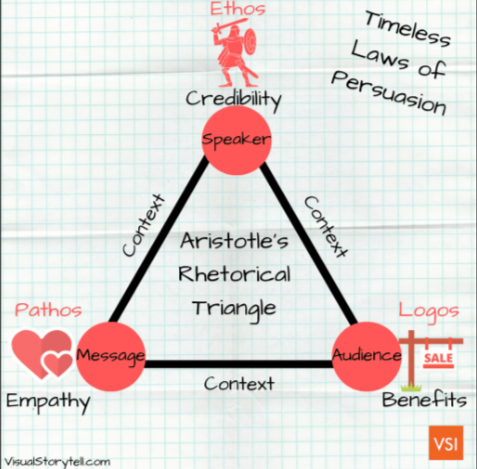Glossary of Rhetorical Terms
1/37
There's no tags or description
Looks like no tags are added yet.
Name | Mastery | Learn | Test | Matching | Spaced |
|---|
No study sessions yet.
38 Terms
Rhetoric
the art of persuasion → how we communicate
Rhetorical situations
The context of a text
cases: context (occasion), audience, speaker, exigence (purpose), subject
context
setting, place, time, culture and how these things might affect the big ideas of the narrative + OCASSION
audience
to whom is the author writing?
speaker
detailed info about author and possible biases or personas
exigence
what is the authors reason or urgency for writing? + PURPOSE (why)
subject
what the author is writing about, literal and thematic subjects
Aristotelian triangle
Rhetorical triangle Writer (person or persona) → Audience (to they share beliefs, values, needs, backgrounds) → Subject (message)

Rhetorical appeals
ethos → credibility (title, trustworthiness, depends on audience)
Logos → logic, rationale/evidence (facts, data, definitions, address counterargument)
Pathos → emotions (values, desires, hopes, fears, prejudices, anecdotes)
diction
word choice (denotation v connotation)
denotation
literal defenition
connotation
emotions and ideas associated with word
Formal/informal diction
formal= professional tone, such as business writing or formal essays
informal = conversational or friendly writing style
syntax
how words (independent/dependent clauses) are arranged to form sentences
independent/dependent clauses
all clauses have a subject and a verb
I- stands alone as complete thought or sentence
D - does not express complete thought or stand alone as sentence (has subordinating conjunction/dependent marker)
coordinating conjunction
joins thoughts → FANBOYS
subordinating conjunction
modifies/clarifies thoughts → dependent marker
simple sentence
1 independent clause
compound sentence
1 independent + 1 independent clause joined by coordinating conjunction (FANBOYS)
complex sentence
1 independent + at least 1 dependent clause w/ subordinating conjunction (after, since, although, because)
compound-complex sentence
2+ independent + at least 1 dependent clause
cumulative sentence
main idea/ independent clause @ beginning
periodic sentence
main idea/ independent clause @ end
parallel structure
repeating word, phrase, or clause for emphasis
antithesis
presenting contrary ideas w/ similar grammatical structure (it was the best of times, it was the worst of times)
Figurative language
using words and phrases to convey a message w/o really saying it (indirectly)
metaphor
calling one thing something else (is)
simile
comparing two things (like, as)
analogy
a comparison between two things, ideas, or concepts typically for the purpose of explanation or clarification
personification
describing something nonhuman as having human characteristics
allusion
call something to mind without mentioning it explicitly; an indirect or passing reference
tone
the combination of diction, syntax and figurative language create an overall impression + suggest authors attitude to the subject
irony
juxtaposition/incongruity between expectation and reality
verbal irony
diff between what writers say vs mean
situational irony
diff between what seems fitting vs what happens
dramatic irony
diff between what character or author says or thinks vs what audience knows to be true
hyperbole
big overstatement (ironic)
understatement
playing things down (ironic)